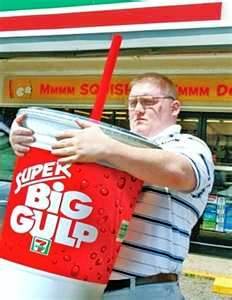Mike Bloomberg Tries to Look Busy with Coke
Mike Bloomberg Looks Busy: Now with the Soft Drinks
 Welcome once again to liberal hold-fast New York City, where you cannot smoke in the park, Central or otherwise (Coming Soon to an apartment building near you!), and soon, you will be deprived of your Big Gulps, Super-Sized High-Fructose-Corn-Syrup-laden Cokes/Pepsi’s/Dr. Peppers/Mountain Dews/Sprites/7-Ups/Hires/Mr. Pibb, etc., if they are sold by food service or small convenience in servings over 16 ounces (Supermarket and grocery sales of higher volume packs are not affected, ostensibly, as they are used over an extended period of time in the home).
Welcome once again to liberal hold-fast New York City, where you cannot smoke in the park, Central or otherwise (Coming Soon to an apartment building near you!), and soon, you will be deprived of your Big Gulps, Super-Sized High-Fructose-Corn-Syrup-laden Cokes/Pepsi’s/Dr. Peppers/Mountain Dews/Sprites/7-Ups/Hires/Mr. Pibb, etc., if they are sold by food service or small convenience in servings over 16 ounces (Supermarket and grocery sales of higher volume packs are not affected, ostensibly, as they are used over an extended period of time in the home).
As Jon Stewart recently pointed out, , one can still order a mountainous heart-clogging pastrami and beef tongue sandwich from the Carnegie Deli followed by Hooters’ wings in New York (if you can find the Hooters), but XXL sugary drinks have got to go.
Why Banning Large Soft Drinks is a Good Idea
 The fact is, obesity is killing us. A can of Coke carries around 160 calories. A 36 Oz. giant coke has 480 calories. All from High Fructose Corn Syrup (HFCS). The effect of HFCS or cane sugar in such large amounts causes the body to go into a heightened state of sugar rush, followed by a withdrawal which makes the body crave more food, usually in the form of more processed carbohydrates. When our bodies cannot metabolize these unused calories (because we are all playing X-Box or watching hockey), the body stores them as fat. Sugar + desire to eat more sugar + sedentary lifestyle = fatso-in-the-making.
The fact is, obesity is killing us. A can of Coke carries around 160 calories. A 36 Oz. giant coke has 480 calories. All from High Fructose Corn Syrup (HFCS). The effect of HFCS or cane sugar in such large amounts causes the body to go into a heightened state of sugar rush, followed by a withdrawal which makes the body crave more food, usually in the form of more processed carbohydrates. When our bodies cannot metabolize these unused calories (because we are all playing X-Box or watching hockey), the body stores them as fat. Sugar + desire to eat more sugar + sedentary lifestyle = fatso-in-the-making.
Mayor Bloomberg made a point this morning on the “Today” show, that when a person is presented with a smaller portion (in this case a 12-16oz. pack of sugared soda), the body is usually sated upon consumption. Our eyes are bigger than our stomachs. He is right.
Why Banning Large Soft Drinks is a Useless Idea (in New York City and Everywhere Else)
One would be hard pressed to find such huge containers in New York City. The city has absolutely zero 7-11’s, and our fast food restaurants in the city proper have no drive-thrus at all (assuming that a super-sized drink sits for a while in a cup holder during a long drive. New Yorkers know nothing of such things due to lack of driving). It would affect movie theaters and sporting events exclusively. Get ready for the jack boots during “The Hobbit” next December.
Fast food restaurants receive their fountain drinks from local Coca-Cola and Pepsi bottlers practically for free. The stores receive lucrative rebates from the beverage giants based on consumption as a marketing ‘spend-back’ for promoting their products in-store. With many fast food outlets offering unlimited access to the soda fountain (now no longer behind the counter), the impact on the consumer is meaningless.
Convenience stores in NYC are generally quite small, and tend to sell 12 oz. to half-liter bottles and cans out of visi-coolers to consumers on the go. You’re bound to find one – to two liter packs in the Korean delis, but, as far as I know, they are not included in the legislation. The 2L bottles there are generally sold warm off the shelf.
Diet Coke, as of 2011, is the second best selling soft drink the US behind Coke Classic, with Pepsi in third. This is all in an environment where overall consumption of Carbonated Soft Drinks (CSD) is in a worldwide decline as consumers move to water and juice or juice/tea-based/functional drinks for health reasons. Note Pepsi’s purchase of SOBE in 2000, and the purchase of Snapple by Dr. Pepper around the same time, to compensate for already-tumbling CSD volumes.
It is also significant to see that Coca-Cola has finally successfully introduced a ‘clone’ of its flagship brand with no sugar, “Coke Zero,” which follows Pepsi’s successful “Pepsi Max” (in Europe for many years, and now finally in the US) as manly no-compromise-on-flavor diet versions of the sugared classics.
Diet CSD’s are not affected by Bloomberg’s ban, so the overall impact will be almost negligible….
Except, in the case of my 11 year old daughter who declared Aspartame causes cancer when it was a choice between a 3-liter sugary root beer (99 cents!) and a two liter Diet Coke at the supermarket last weekend.
Guess which one dad bought!
As Usual, Bloomberg has Missed the Point: What Should be Done.
 Store-level communication to responsible adults about the pros and cons of sugared CSD’s vs. diet CSD’s should be considered by the leading companies. Coca-Cola and Pepsi-Cola can responsibly communicate to consumers the pros and cons of sugar vs. sugar-free, and not lose the sale in the process. Knowing as I do that 2L of Diet Coke sweetened with Aspartame is far better for the family than 2L of ‘Classic’ sweetened by HFCS or sugar, I can make that informed decision, but the bulk of consumers need to be informed by the manufacturers of the risks and benefits of both options. It’s good, honest marketing leading to better decisions made by informed consumers.
Store-level communication to responsible adults about the pros and cons of sugared CSD’s vs. diet CSD’s should be considered by the leading companies. Coca-Cola and Pepsi-Cola can responsibly communicate to consumers the pros and cons of sugar vs. sugar-free, and not lose the sale in the process. Knowing as I do that 2L of Diet Coke sweetened with Aspartame is far better for the family than 2L of ‘Classic’ sweetened by HFCS or sugar, I can make that informed decision, but the bulk of consumers need to be informed by the manufacturers of the risks and benefits of both options. It’s good, honest marketing leading to better decisions made by informed consumers.
And not by a third-term mayor with nothing else to do.
ANDREW ROMEO
An Insider’s Perspective
Reporting Safely from New Jersey for SnusCENTRAL.org
About author
You might also like
WHATEVER HAPPENED TO SNUS IN THE USA?
If I recall, the cost of a mini-snus factory should not run over $3 million. That’s with standard primary and Mertz machines, plus re-wetting, and, the variable, refrigerated facilities for
SELLING SNUS IN SCANDINAVIA: A PRIMER
It’s difficult being in Big Tobacco and running its snus business in Nordic Europe. It’s even more difficult if you are in Small Tobacco, and don’t have a cigarette business
BP Can’t Stop Screwing Up.
I am a liberal. Don’t like guns, but won’t hug any trees. I eat animals, and distrust big corporations because I have worked for them. The FDA is over-worked, under-skilled



